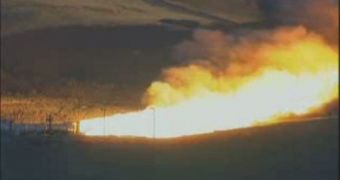Despite the fact that the faith of Project Constellation is nearly sealed, experts at NASA and contractor Alliant Techsystems (ATK) have just finished running a new rocket motor test, of the engine that was supposed to go on the ARES I delivery system.
This was a critical part of the Project, namely the component that was supposed to take the Orion Crew Exploration Vehicle to low-Earth orbit.
The rocket itself was planned to have two stages, with the first one featuring five segments. Yesterday, August 31, NASA and ATK engineers tested the second variant of the first stage, called the DM-2.
The test came less than a year after the successful test firing of DM-1, which was carried out in September 2009, Space reports.
According to specifications, the new motor is about 47 meters (154 feet) long, and is capable of generating an estimated 3.6 million pounds of thrust. It also produces 22 million horsepower.
The DM-2 test was developed in such a manner so that experts could assess how the solid rocket booster behaves in freezing temperatures, of 4.4 degrees Celsius (40 degrees Fahrenheit).
“The experience gained during this test is all contributing to our understating of what it takes to make these decisions,” said Doug Cooke.
Cooke, who is the associate administrator for space exploration at NASA, spoke to reporters soon after the tests were completed.
The telemetry “look absolutely excellent. We captured all the data we were after and we're looking very much forward to being able to further asses,” added Alex Priskos.
The expert is the first stage manager for the Ares Projects at the NASA Marshall Space Flight Center (MSFC), in Huntsville, Alabama.
“This team here is focused entirely on this test. This is part of the existing Constellation program plan and that work is continuing,” said before the tests Jennifer Morcone, a spokeswoman for NASA.
The test burn began at precisely 11:26 am EDT (1526 GMT), and took about two minutes to complete. During this time, complex measurement instruments were hooked up to the rocket stage.
This allowed engineers to collect all the data they needed on hundreds of parameters related to how the rocket would behave in the coldness of space.
“Tests such as DM-2 allow our team to improve and enhance existing technology essential to maintaining America's preeminence in space, even as we look to new designs, new materials and new technologies with the potential to transform the future of human spaceflight,” concludes MSFC expert Andy Schorr.

 14 DAY TRIAL //
14 DAY TRIAL //